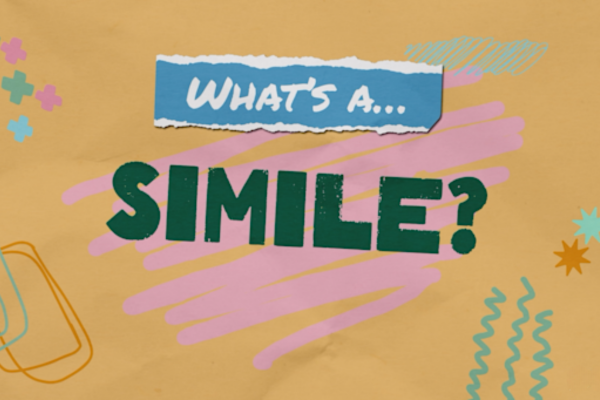27 February 2025
ELA Glossary: 30+ Simple Definitions Everyone Should Know
Elise Czyzowska
Senior Content Marketing Executive
Recently, we shared our 70+ term Theatre Glossary, and now, to complete the set, we're following up with an equally comprehensive ELA Glossary of Literary Devices!
This English Glossary includes 30+ key terms across three sections:
Key Writing Concepts
AUDIENCE
The audience are the intended readers for a written work, or the people listening to a speech or performance.
CONTEXT
The context is the background, setting, and surrounding events in which a written work is situated, or the circumstances in which the story itself is situated.
For example, the prologue of Antigone provides context for the play.
FLASHBACK
A flashback is an event or scene that takes place before the present time in the story.
For example, in Death of a Salesman, Willy has flashbacks when he relives memories of the past in the present, such as when he has a conversation with his dead brother while playing cards with Charley.
Explore the DT+ Arthur Miller Collection here.
FORM
The form is the genre of text, as well as the type of text itself, such as a play, a novel, or a poem. Dramatic forms include Musical Theatre, Satire, and Farce.
LANGUAGE
Language is the style of writing created by the specific word choices of the author.
MOOD
A mood is the feeling that a written work inspires in the reader.
For example, at the start of Hamlet, Shakespeare creates a spooky mood full of dread with the lines "How now, Horatio? You tremble and look pale."
Jump from page to stage and see how different productions stage these opening lines with our Hamlet Interactive Playtext!
MORAL
A moral is the lesson that a story teaches.
POINT OF VIEW
A point of view is the narrator's position in relation to how the story is told:
- First-person: a single narrator tells the story, using pronouns like "I" and "we".
- Second-person: the narrator tells a story about "you".
- Third-person: the narrator tells the story about other people, using pronouns like "he" or "she".
PURPOSE
A purpose is the author's reason for writing.
Do you know the purpose behind Henrik Ibsen's A Doll's House? Find out here...
SOURCE MATERIAL
Source material is the original information or text on which a written work is based.
For example, Into the Woods is based on a variety of fairy tales.
STRUCTURE
A structure comprises the elements that form the framework of written work, including sentence and paragraph structure, narrative point of view, and sequence of events.
TONE
Tone is the attitude of the writer towards the subject.
For example, in Macbeth, Shakespeare's tone is menacing and foreboding, whereas in As You Like It, it is humorous and light-hearted. Explore the full Shakespeare Collection here.
Literary Devices
ALLEGORY
Allegory is when a story or poem can be interpreted as having a hidden meaning, particularly a moral or political one.
For example, Arthur Miller's The Crucible is an allegory for McCarthyism.
ALLITERATION
Alliteration is the repetition of the same letter or sound at the beginning of words that are located near each other in a text.
ALLUSION
Allusion is the reference to something such as a well-known character, event, theme, or story.
ANACHRONISM
Anachronism is something (or someone) that is not in its correct historical or chronological time, especially a thing or person that belongs in a different time.
For example, when Brutus says "Count the clock!" (Act 2, Scene 1) in Shakespeare's Julius Caesar, this is anachronistic, as clocks did not exist in Ancient Rome.
ANTHROPOMORPHISM
This is the act of giving human characteristics to something that is not human.
Anthropomorphism is seen throughout Alice in Wonderland, such as when the Caterpillar speaks to Alice upon their first meeting.
COLLOQUIALISM
Colloquialisms are informal or day-to-day conversational language.
EUPHEMISM
A euphemism is a word or phrase that is used as a milder substitute for language that is offensive, harsh, or blunt.
FORESHADOWING
Foreshadowing is an indication or hint that something will happen in the future of the story.
The fact that Romeo and Juliet will die is foreshadowed many times throughout the play:
- "A pair of star-crossed lovers... Doth with their death bury their parents strife" (Prologue)
- "I fear too early, for my mind misgives / Some consequence yet hanging in the stars" (Romeo, Act 1, Scene 4)
- "My life were better ended by their hate / Than death prolonged, wanting of thy love" (Romeo, Act 2, Scene 2)
HYPERBOLE
Hyperbole is an obvious exaggeration.
What's... Hyperbole is just one e-learning video in our ELA Class Starter series!
IMAGERY
Imagery is the use of language in such a way that it appeals to one or more of the physical senses (taste, touch, sight, smell, or hearing).
IRONY
Irony is when the intended meaning of a word or phrase is different from its actual meaning.
The three types of irony are:
- Dramatic Irony: when the audience knows something about the situation that the character does not.
- Situational Irony: when an unexpected action occurs that is in direct contrast to what one would expect to happen.
- Verbal Irony: when a character says something contradictory to what they actually mean.
JUXTAPOSITION
Juxtaposition is when two or more ideas, places, scenes, or characters are placed side by side to compare and/or contrast them.
METAPHOR
A metaphor is a figure of speech that compares two unrelated things that have similar characteristics, without the use of "like" or "as".
MOTIF
A motif is an idea that repeats itself throughout a written work.
ONOMATOPOEIA
Onomatopoeia is a word that imitates the sound of a thing, i.e. "buzz".
PARADOX
A paradox is a statement that seems to contradict itself, but in reality, expresses a truth.
PERSONIFICATION
Personification is a figure of speech in which an idea or animal is given human attributes.
REPETITION
Repetition is a literary device where words, phrases, or sentences are used more than once, often to achieve a particular effect.
For example, in Shakespeare's Richard 3rd, Richard repeats the words "tongue" and "tale" as he considers his fate:
"My conscience hath a thousand several tongues / And every tongue brings in a severed tale / And every tale condemns me for a villain" (Richard, Act 5, Scene 3)
SIMILE
A simile is a figure of speech that makes a comparison, showing similarities between two unlike things using "like" or "as".
Explore similes with this free recital video of Emily Dickinson's I'm Nobody! Who are you?...
SYMBOLISM
Symbolism is the use of characters, settings, images, or other elements to stand for bigger ideas.
For example, in Long Day's Journey into Night, the fog is a symbol of escaping from reality. When the foghorn blows, it symbolises the intrusion of reality on the fantasies of the characters.
Essential Key Terms
Help your students develop their analytical skills and learn to construct persuasive arguments in essay responses with this Close Reading Revision Worksheet.
This free resource includes:
|
 |
Plus, included in this worksheet is a ready-to-go 'Essential Key Terms' Glossary ideal for knowledge retention and subject revision...
Download the exclusive Close Reading Revision Worksheet today!
This glossary has been adapted from An Interactive Glossary of Key Writing Concepts and Literary Devices, written by Matteson Claus, and is available to customers on the Digital Theatre+ platform.
Not a customer? Click here to chat with our Sales Team today!
Related blogs
Costume Glossary: 20 Essential Key Terms You Need to Know
The latest addition to our series of ELA and Theatre Glossaries, we've created this comprehensive...
Read moreAre you teaching... Acting?
In today's blog, we're sharing a curated resource selection to help you introduce key acting...
Read moreTheatre Glossary: 70+ Simple Definitions Everyone Should Know
What's the difference between a 'dress rehearsal' and a 'technical rehearsal'? Who is in charge of...
Read moreGet the latest teaching tips straight to your inbox
Explore free lesson ideas and inspiration, education news, teaching trends and much more by signing up to regular blog updates!





